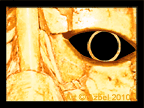A new technology resulted in the remains of a previously unknown city in Honduran jungle. Still not confirmed that belong to the Mayan civilization.
Photo: UTL Productions, LLC
The Honduran Mosquitia's dense canopy of treetops towering 164 feet above the forest floor may well be hiding remnants of the fabled Ciudad Blanca, or White City, sought by Hernán Cortés for its gold. Scientists have detected probably man-made structures from aircraft using laser-based technology, according to the American Geophysical Union.
From the air it looks like a sea of green. But bounce some laser images off the terrain, lift up the trees via computer imaging, and the dim outlines of square structures are revealed beneath the Mosquitio section of the Honduran rainforest.
A complex of mounds and, possibly, ancient building foundations becomes visible (bottom image) when laser reflections from the tree canopy (green in top image) are filtered out of the lidar data from a site in the Mosquitia region of Honduras
The discovery represented a true juxtaposition of ancient and modern, art and life: Elkins and Benenson teamed up with scientists at the University of Houston who specialize in light-detection-and-ranging (lidar), a high-tech imaging technique involving lasers. Traveling in a slowly moving small jet flying low over the dense jungle, the researchers pelted the trees with billions of laser pulses to get a glimpse below the forest canopy, The New Yorker reported in a seven-page article on the expedition.
The resulting images revealed straight edges and other features that don’t tend to occur in nature; University of Houston engineer Bill Carter said he saw the outlines of a pyramid immediately. In fact, The New Yorker article states, the ancient ruins could be vast and include cities, villages, roads, canals, ceremonial sites, agricultural terraces and other features, “potentially the remains of a previously unknown civilization.”
The idea is that it could be the fabled Lost City, which Cortés struggled to find, to no avail. Because of its reputation as being stuffed with gold, the research team did not divulge its exact location in order to keep looters away. The two are planning a documentary based on the expedition. They plan a trip to the site later this year.
Aside from the excitement over this find, the discovery method itself could open up many impenetrable sites to exploration, scientists said. "This technology is going to revolutionize archaeology," archaeologist Christopher Fisher of Colorado State University told The Atlantic. "We used to have to walk through the jungle, hacking our way through, recording every architectural feature, every trace of ancient habitation that we used to find. Incredibly labor intensive."
The scientific team presented the findings officially at the American Geophysical Union’s Meeting of the Americas in Cancun on May 15, according to a statement from the organization.
Source: UTL Productions, LLC, ICTMN Staff, Video: UH Multimedia




















































































































































































































0 comments:
Publicar un comentario